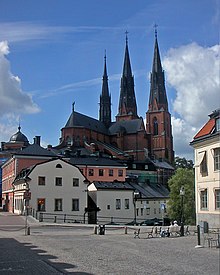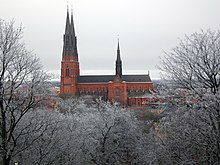Uppsala Cathedral

Uppsala Cathedral (Swedish: Uppsala domkyrka) is a cathedral located centrally in the city of Uppsala, Sweden. It dates back to the late 13th century and at a height of 118.7 m is the tallest church building in Scandinavia. Originally built under Roman Catholicism and used for coronations of the Swedish monarch, since the Protestant Reformation, it has been controlled by the Lutheran Church of Sweden. It is the seat of the Archbishop of Uppsala, the primate of Sweden.
History
The construction of the cathedral began in 1287 after the archbishopric was moved from Old Uppsala (Swedish: Gamla Uppsala). It took more than a century to complete. When inaugurated in 1435 under archbishop Olaus Laurentii, the cathedral was not completely finished. It was dedicated to Saint Lawrence, highly cherished in all of Sweden at that time; Saint Eric, the patron of Sweden (though never canonised by the Roman Catholic Church); and Saint Olaf, the patron of Norway. It was completed within the following decades.
Architectural alterations

The Cathedral was severely damaged in the conflagration of 1702, which caused extensive damage to its twin spires. When rebuilt, the Renaissance style of 1619 was modernised. Under the architect Carl Hårleman (1700-1753) the tall Dutch Renaissance spires were replaced with small, dome-like towers in Baroque style.
Between 1885-1893, the architect Helgo Zettervall (1831-1907) oversaw a second restoration, intending for the cathedral a French Gothic revival appearance, which was popular in the late 19th century. The original, medieval style was Baltic International Gothic, characterised by relatively robust brick walls. He replaced the small Baroque towers with tall (French-inspired) spires, including a third, smaller tower on the transept crossing in the same style. Zettervall also so significantly altered large portions of the medieval outer brick walls as to give it a slimmer appearance. He removed the white-washed "blind windows" which had been similar to those on parts of the nearby Holy Trinity Church (Swedish: Helga trefaldighets kyrka).
The interior ceiling and walls of the cathedral were decorated in neo-Gothic style. Some depictions, such as one of the Reformation's Martin Luther, added figures beyond the cathedral's medieval heritage. Large portions of cement additions by Zettervall to the exterior structure of the cathedral were removed decades later as they adversely affected the building's fabric.
A sign denouncing antisemitism marks the position of the "Jewpig", a relief depicting Jews drinking from a sow.
Usage

In the Middle Ages, when all houses in Uppsala except the churches were one- or two-storey structures made of wood or sometimes bricks, the cathedral must have seemed even more enormous than today. The church was not the regular place of worship of laypeople until the Reformation. It was reserved for official services of the Catholic Church hierarchy (by the cathedral's canons). The parish churches in Uppsala were the Holy Trinity Church, or "Farmers' Church" (Swedish: Bondkyrkan) as it was often called; Saint Peter's church (Swedish: S:t Pers kyrka); Our Lady's Church (Swedish: Vår Fru); and a Franciscan friary. The last three had been built on the east side of the Fyris River (Swedish: Fyrisån), which was (and is) the central business district. They were successively torn down during the Reformation.
The Cathedral was also the coronation church for many of Sweden's kings and queens. It was the site of celebrating coronations from the Middle Ages until the end of the 17th century. Thereafter, up until 1872 (when Oscar II was the last Swedish monarch to be ceremonially crowned), Stockholm's Cathedral Storkyrkan was the official coronation church.
Interred notables
A number of Swedish kings and notable people were buried inside the cathedral:

- Gustav Vasa, 15th century, King of Sweden. He is buried with his three wives, although only two are depicted on the sarcophagus designed by Willem Boy. The king was interred in what was once the Chapel of the Virgin Mary. The only remaining indication of the original intention of the chapel are the painted yellow stars against a blue background on its vaulted ceiling, symbols of Saint Mary in Catholic tradition.
- John III of Sweden (son of Gustav Vasa) and his wife Catherine Jagiellon.
- Carolus Linnaeus, 18th century world-renowned botanist.
- Olaus Rudbeck, famous Swedish polymath and one of the discoverers of the lymphatic system (He also wrote Atlantica, a book in which he attempted to demonstrate that all peoples of the world originated in Sweden, and that Uppsala was the lost Atlantis).
- Emanuel Swedenborg, 18th century scientist and mystic. He was not originally interred here, but his remains were transported to Uppsala from England in 1908.
- Nathan Söderblom, 19th-20th century notable archbishop, Nobel Peace Prize recipient.
- Eric the Saint, 12th century king and national saint in the 16th century Renaissance style relic casket given by Catherine Jagiellon.
- Laurentius Petri, Sweden's first Lutheran archbishop.
- Relics of Saint Bridget (Heliga Birgitta) were placed in the chapel of Saint Eric and Bridget's parents.
- Folke Johansson Ängel, Archbishop of Uppsala (1267–1277)
Dag Hammarskjöld memorial
In the cathedral is a small memorial to Dag Hammarskjöld, former Secretary-General of the United Nations, who was posthumously awarded the Nobel Peace Prize. A stone bears the inscription:
Icke jag
utan Gud i mig
Dag Hammarskjöld 1905 – 1961
The English translation is "Not I, but God in me."
